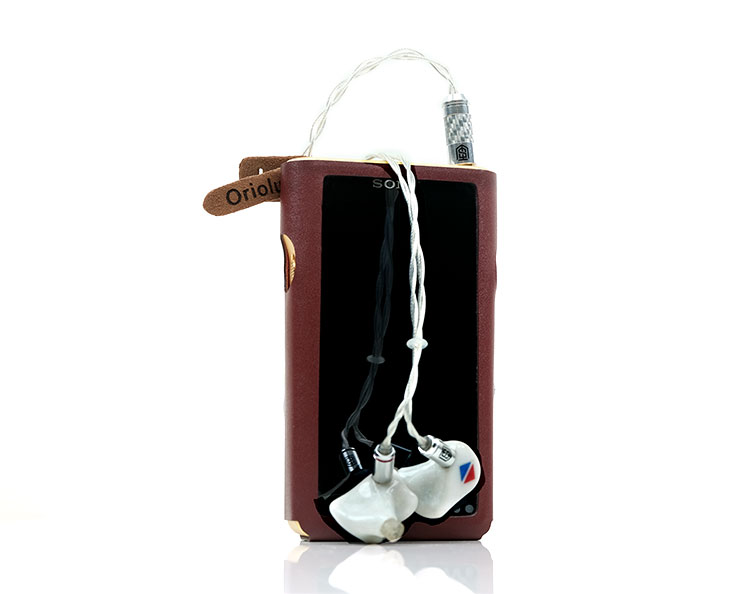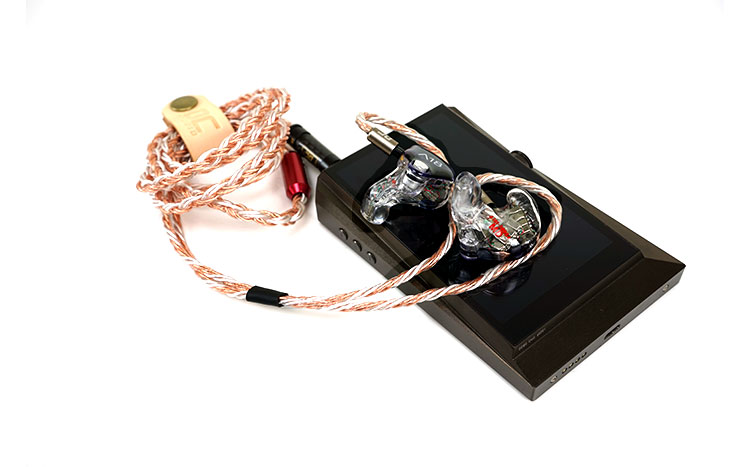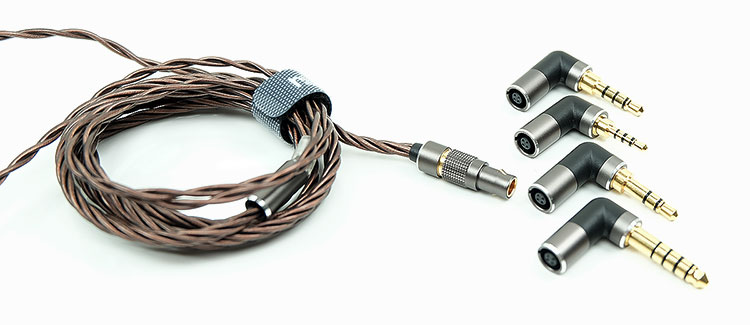Sound Impressions
Summary
If you are arriving here thinking you will get the silver “meme” for sound from the Medusa you will be sadly mistaken. This cable surprised me a lot. Not just for the outstanding performance to price ratio but for the ability to get a fairly full-bodied and warm, neigh smooth sound, that often sounded smoother than some copper cable or SPC variants.
This is not a Thor II Junior, it does not quite have that separation and sparkle beyond the mids but it does come very close indeed to my ears, especially in the level of dynamic range and the better bass response.
When I mention better our point of context is pretty much every stock 4-wire OFC non-Litz build wire you find in a lot of monitor packages. Brands such as Plastic’s One come to mind. The Medusa will basically condemn them to the compression and boring bin.
Where do these two silver cables differ? Probably in the way the Medusa delivers the upper mids and treble. They sound smoother and wetter on the test monitors we used rather than sparkling and energetic. There may well be a degree of attenuation there introduced by Satin Audio to retain that overall smooth and slightly linear delivery.
Timbre
The harmonic balance of the Medusa is just slightly to the even or lower-order side and there is less treble “heat” compared to the likes of the BGC Starlight.
Thus, there is nothing lean about the Medusa timbral influence, in fact, you could be forgiven for thinking this might be a traditional copper tone. Even on neutral to slightly bright monitors such as the Hum Delores, which I tend to like as a reference monitor for cable testing, it sounded relatively detailed but dense at the same time.
However, the Medusa doesn’t sound overly punchy on the low-end either despite the body. Whilst it delivers some warmth into the instrumental timbre and slightly less of an odd-harmonic edge there is still a relatively linear and coherent response being followed.
Resolution
The resolution or refinement of the Medusa is excellent, particularly with neutral monitors such as the Delores and the 64 Audio A18. If you are coming from OFC black coated 4-wire stock cables you will get a big jump in dynamic range as well as a stronger perception of nuanced imaging in complex instrumental passages.
One thing I noticed about the Medusa compared to the likes of the Ares II was just how much more expansive it sounded in the upper mids and lower treble on these two neutral monitors.
The Ares II will still deliver detail but it sounded much more center-focused to my ears than the Medusa which pushed the presentation out a little taller and wider. Combined that with a more refined less edgy treble timbre you get a more enticing combo of a sweeter timbre plus a wider upper soundstage.
Example
One example of this effect that came to mind was on DJ Ten’s “Electric Airglow” from his Zioneon EP. This is a synth-based track where the BPM is less on the low-end but more centered in the mids and quite forward also. You do get a solitary kick drum on the low-end but it is not the driving force of the track.
With the Medusa, I felt the driving BPM of the synth was a bit lighter in weight but more expansive or holographic in positioning with a just smidgen more headroom and detail. The Ares II felt the denser sounding of the two cables, just lacking the reach and air of the Medusa.
Matchability
I tended to gravitate with neutral monitors or hybrids with an expansive sound with the Medusa. IEMs such as the 64 Audio Tia Trio, Hum Delores, and to some extent the more musically tuned Campfire Audio Solaris got my vote for pairing.
I say to a lesser extent with the Solaris because the supplied SuperLitz cable that it comes with is already a great cable and there is less of an upgrade gap between these two, particularly if you like your presentation punchy.
What I did like was how refined the Solaris top-end sounded with the Medusa with a slightly wetter smoother delivery though it didn’t quite have the low-end punch I was looking for to place it as a top candidate.
Warmer presentations such as the Soranik DES were just ok for me but ultimately felt a little too soft in its harmonic balance and not enough sparkle, even when attached to something very neutral like the AMP1 MKII amped iBasso DX220.
Neutral or Hybrid
Instead, the 64 Audio Trio, A18, and Hum Delores seem to benefit most with Medusa’s smooth and linear delivery. These are monitors that already have excellent mids and treble presentations with tons of headroom.
The Medusa seems to jive well with those existing properties by adding slightly more body and refining the treble to lower any potential edginess and sibilance without loss of detail.
I was particularly impressed also with how clear and responsive the tia Trio hybrid dynamic driver was with the Medusa, even more so than the Solaris dynamic driver. Combined with the excellent staging the tia Trio offers this was the pairing I ended up with time and time again.
Select Comparisons
Effect Ares II
$149.90
Technical
Coming in at $60 cheaper, the Ares II is the bread and butter of the Effect Audio’s Premium Series range of IEM cables. This is also a Litz build but EA does not reveal what type of Litz unlike the Type 4 of the Medusa. The wire gauge on both is the same at 26AWG though EA uses a multi-stranding technique whereas I do not believe this is the case with the Medusa.
The big difference between these two cables is the specific wiring used. The Ares II uses a UPOCC Litz copper whereas the Medusa uses an OCC High Purity 6-7N Silver. That should make a qualitative difference in the tonal balance of these two cables and present a clear choice for those who have preferences.
Both have supple build qualities with very low microphonics, and little or no memory retention. The slightly longer braiding throw technique of the Medusa does make it marginally stiffer.
These two cables can also come with a wide variety of terminations and barrels though I do prefer the Medusa all silver carbon fiber finish compared to the darker tones of the Ares II barrels. The darker tones do work better on copper cables though like the Ares II.

Performance
I have never really found the Ares II to follow the thick, rich copper myth. It is rather more neutral than you would think, certainly compared to the Medusa it tows a slightly more neutral line with a little less bass weight on the Hum Dolores, (our reference IEM for these tests).
The Medusa seems to tease out a little more depth and textural detail, which in turn, offers a level of instrumental layering that is a touch more holographic in the mids. Though both are 4-wire the Medusa does offer a little more dynamic range than the Ares II. Something more akin to the Thor II in terms of low-end response and treble detail. Vivid is an apt term here.
With the Dolores, I also found vocals to be a little more refined though positioning-wise slightly different. If anything, your first reaction will be that the Ares II has the better vocal focus or a more forward positioning on the Delores.
However, I feel that is more to do with the slightly more subdued top-end detail and energy compared to the Medusa. Vocals are cleaner, smoother, and slightly less edgy on the Medusa but also a little more neutral in their positioning. The Medusa also allows the Delores to deliver a bit more treble air and clarity that, in turn, opens up the soundstage a bit more compared to the Ares II.
OC Studio Monarch
$215
Technical
OC Studio hails from Taiwan and produces some amazingly good value cables, especially if you live in Taiwan where it can be even cheaper. We reviewed the Orpheus MK5 8-wire which was around $250 in the overseas market and promptly gave it a Bang For Buck 2018 award it was that good.
We have another now, the Monarch 8-wire, and is around $215 for the 8-wire local pricing in Taiwan which places it square-on with the 4-wire Medusa.
The Monarch is a hybrid 8-wire 24AWG UP-OCC single crystal copper and single crystal silver. The large strand count and bigger gauge of wire make this a far bigger and heavier cable than the 4-wire 26AWG Medusa.
Design
The visual aesthetic is also quite different with a mix of copper and silver tones under a translucent jacket as well as red and white barrel rings compared to the complementary chrome and silver of both the wire and barrels of the Medusa.
You can ask for a wide variety of terminations including 2-pin and MMCX though it is not that clear on their website. I suspect you need to email them to request which one specifically you want.
For such a large cable it handles remarkably well due to the supple PVC jacket. It has super tight braiding and can bend just a little easier than the Medusa. Its resistance to microphonics is even better than the Medusa also, even above the splitter.
However, it does have memory wire and the additional weight might make its presence felt that bit more than the lighter Medusa when on the ear. Still, for me, this is a comfy fit.
Performance
There are a few tonal differences between these two cables but first, the elephant in the room. This is an 8-wire 24AWg build so yes, the resistance is lower and the dynamic range is slightly the better of the two. However, what surprised me was that the gap between these two in terms of dynamic range was not as big as I thought it would be on our Hum Dolores test monitor.
The reference nature of the Delores did help us pinpoint a few tonal changeups between these two. The Monarch does have beefier punchier low-end on the Delores and it does bring out a bit more sub-bass presence and detail. The Medusa is a bit more linear in that regard though it is fairly full-bodied throughout.
The Medusa also seems a touch smoother in terms of harmonic balance with a little more even-harmonic bias in its instrumental timbre. In contrast, the Monarch has a touch more contrast and bite for its timbre, especially percussion presence and acoustic plucks.
Overall, the Monarch displays a bit more dynamic range, a punchy more extended low-end, and a bit more treble contrast whereas the Medusa is a bit smoother and more linear or neutral in its delivery.
DUNU Hulk
$299
Technical
At a slightly higher price is the Hulk from DUNU. This is a very different proposition to Medusa on every level. Timed for release alongside the DK-4001 flagship monitor, it is an aftermarket cable complete with a wide variety of changeable terminations.
Unlike the Medusa which you have to choose which one at check out, the Hulk comes with 4 connectors for balanced and unbalance making it a very flexible option. Connectors include 3.5mm balanced and unbalanced, 2.5mm TRRS, and 4.4mm.
This is a much bigger cable than the Medusa. The wire is a huge 22AWG OCC copper Litz Type-2 4-wire compared to the more technical Litz Type-4 but smaller 26AWG 4-wire OCC Pure Silver of the Medusa.
Build
The braiding is done by hand using a translucent PVC jacket and terminated with 0.78mm connectors. DUNU does not offer the same wide range of connector choices for the Hulk with only MMCX or 2-pin compared to Silk Audio’s 15 choices for the Medusa.
The visual could not be the more opposite with the striking silver and chrome tones of the barrels and wire of the Medusa compared to the chocolate brown and black carbon fiber printed barrels of the Hulk.
And yet, for the size, the Hulk handles supremely well with plenty of flex, a tight braid, and next to no microphonics below the splitter. What I found with the Medusa was a lower level of microphonics below the splitter but a higher level above the splitter.
This may have something to do with the lack of memory wire on the Medusa and the slightly longer braiding technique. Or simply the insulation is a touch stiffer.
Performance
It costs a bit more and has a larger gauge of wire so naturally, I do detect a slightly better level of dynamic range with the HULK’s performance using the Delores. However, once again the gap is not as big as you would expect and many of the differences are more about timbre than annoying compression or a lack of range.
Comparing these two I actually find the Medusa to be the smoother and slightly the warmer of the two. I was not expecting that. Neither have any issues with allowing the Delores enough air and headroom but the Hulk seems to have a little more treble vibrancy, which, in turn, creeps into percussion and string timbre.
As a result, the Medusa sounds a touch more rounded and even-harmonic biased with the Delores whereas the Hulk has a bit more sharpness and clarity. In short, percussion presence is stronger on the Hulk, guitar timbre ‘crunchier’ but overall, not necessarily fuller sounding than the Medusa.
Our Verdict
Color me impressed with this pure silver cables performance and looks for the $209.90 asking price. It defies the meme of silver being bright and analytical and instead delivers a much warmer, fuller sounding presentation which works wonderfully well with neutral monitors which excel at staging and headroom.
It also looks great and handles like a boss. 4-wire often has that advantage over 8-wire and whilst I would not class it as quite as flexible as an Effect Audio tight braiding build it is nevertheless really light on the ear with low microphonics. The silvery chrome carbon fiber barrels are just top-notch also and much better than the darker printed versions I have seen on other cables.
You may find me recommending this one moving forward for those looking for silver on a budget but not necessarily a bright cable. Certainly, if you are asking me on “Bang For Buck” without cheapness, the Satin Audio Medusa is one of those cables that will crop up in my responses quite a lot.
Satin Audio Medusa Specifications
- OCC Pure Silver Type 4 Litz
- 26AWG
- Cryogenic Treatment
- Highest purity silver
- Kelvar Damping Core
- Audio grade Mundorf MSolder SUPREME from Germany
- Handcrafted in Vietnam






